#visit granada spain
Explore tagged Tumblr posts
Text
Granada : Discovering the Beauty of Spain's Moorish Gem
If you’re looking for a city in Spain that’s brimming with history, culture, and natural beauty, Granada should definitely be at the top of your list. Located in the southern region of Andalusia, Granada is a city that’s steeped in history and known for its Moorish architecture, stunning views, and vibrant culture. In this article, we’ll take a closer look at what makes Granada such a unique and…
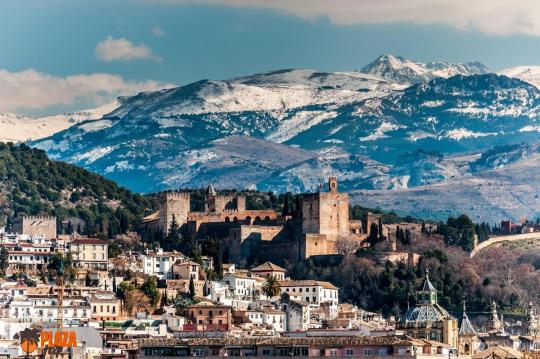
View On WordPress
#alhambra granada#goles granada#granada#granada alhambra#granada andalucia#granada city#granada spain#granada spain tour#granada spain travel#granada spain travel guide#granada spain vlog#granada tour#granada travel#granada travel guide#jugadores granada#things to do in granada#things to do in granada spain#visit granada spain#walking in granada
0 notes
Text
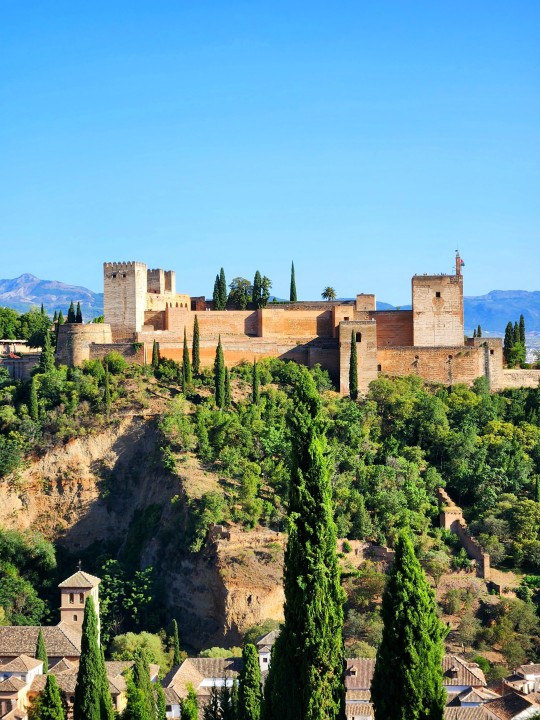
The Alhambra, Granada | Spain | 2023
#travel#travel blog#wanderlust#travel photography#europe#travel europe#spain#granada#alhambra#visit spain#visit granada#visit the alhambra
230 notes
·
View notes
Text









#alhambra#the alhambra palace#granada#this palace is one of the most beautiful historical places#it contains stories songs poems art sculpture and beautiful gardens#one of the places I would like to visit one day#spain#قصر الحمراء#غرناطة#إسبانيا#garden#history
11 notes
·
View notes
Text

HOW TO ACCESS THE ALHAMBRA IN GRANADA
Detailed guide to visiting the Alhambra of Granada, Spain’s marvel of Islamic art: tickets, entrances and opening hours
@gw-360
#alhambra#alhambragranada#granada#spain#travel#how to visit#how to#spain travel#alhambrapalace#albayzin#palaciosnazaries#generalife#laalhambra#gw360#greenwhereabouts#greenwhereabouts360#gw360blog
0 notes
Text
I genuinely can´t believe the south of Spain is one of the most touristic places in Spain in summer. ITS SOO FREAKING HOT HERE
#sorry if i misspelled anything#spain#andalusia#sevilla#almería#huelva#codoba#malaga#jaen#granada#I understand why people want to visit#like yes i know we are the best thing in all of Spain but in summer its the worst#i want to put the ac during the nigth#but i cant my parents would get mad at me#but its sooo hot rn#I want to use the manual fan while im sleeping but i cant#😭#(S)pain#im in Spain without the S#seriously#that phrase defines Spain oo well but you cant say it here unless your friends know english
0 notes
Text






The streets of Cartaya, a pretty town in the Huelva Province (southern Spain).
Founded in the XV Century by the Marquis of Gibraleón, Cartaya has a bit less than 19.000 inhabitants. Big it may not be, but charm it doens't seem to lack.Yes, it doesn't have te monumentality and the appeal of other cities in Andalucia (like Ronda, Córdoba or, above all, Granada), but Cartaya certainly deserves a visit.
#Cartaya#Andalusia#andalucia#Andaluzia#Provincia de Huelva#Huelva Province#spain#espanha#españa#original photos#photography#photographers on tumblr
42 notes
·
View notes
Note
Hi, Lola!! Since you have your travel side blog I want to know your top 3 cities in the world, please??
hi desi! oh this is a REALLY hard one! i've given up on one and i'm doing ten because i couldn't choose, so sorry. this is all based on my favourite travel experiences - if i had to pick somewhere to live that might me different but these cities were my favourite to visit (in no particular order):
1. istanbul, turkey
2. rio de janeiro, brazil
3. amsterdam, the netherlands
4. hoi an, vietnam
5. cusco, peru
6. sarajevo, bosnia and herzegovina
7. krakow, poland
8. granada and seville, spain (cheating with two so sorry).
9. kauai, united states of america
10. berlin, germany
honourable mention to new orleans but i couldn't kick anything else off the list!
ask me a random question!
24 notes
·
View notes
Text
GOetry - A Spanish Flamenco
For the third week of the GOetry world tour, we're heading to Spain! But before we begin, let’s take in the beauty of Spain itself.
Wander through Seville and visit the stunning Plaza de España before strolling through the lively streets of Barcelona, where Gaudí’s masterpieces ignite the imagination. Fall in love with the breathtaking Alhambra palace in Granada and then we can dance the night away in Spain’s capital city of Madrid.
From the surreal mosaics of Park Güell to the sun-kissed vineyards of La Rioja, Spain has long been a land of art, rhythm, and deep emotion. And, of course, what would Spain be without Flamenco? This week, we embrace the raw emotion and musicality of Flamenca poetry, a form that beats with the heart and soul of traditional Flamenco music.
This week’s prompt:
Form: Flamenca
Theme: Dance
What is Flamenca Poetry?
The flamenca is a Spanish quintain (or 5-line stanza) form with a staccato rhythm meant to replicate the click of heels by flamenco dancers. The flamenca goes by a few other names, including seguidilla gitana (or Gypsy seguidilla), playera, and/or sequiriya.
Here are basic guidelines of the flamenca:
5 lines
lines 1, 2, 4, and 5 have 6 syllables
line 3 has 5 syllables
lines 2 and 5 assonate
Example:
I stamp and click my heels
marking beats with my feet
swirling scarlet skirts
His Spanish eyes see me
Then, we have ten children
Lesley Scoble, September 2023
Post your results here with the #GOetry and don't forget to tag me @isiaiowin or add them to the GOetry collection on AO3!
Have fun! ~Moon 💚
@goodomensafterdark
13 notes
·
View notes
Text

Months before I left for my trip to Granada, Spain, I was hit with a stroke of extraordinary luck: Hoopoe Press asked if I'd like to get a review copy of the new, full translation of Radwa Ashour's Granada trilogy, a multigenerational epic of Arabic literature describing the fall of Muslim rule in medieval Spain and the impact it had on real families in the city of Granada and throughout Andalusia. Um...YES I wanted one! This is the first time the entire trilogy has been available in English translation, thanks to translator Kay Heikkinen; the entire series comes in an impressively compact package, complete with a foreword by Marina Warner.
I'm only one novel in, and am just starting sequel Marayama now, but trust me: the first book, at the very least, is an absolute must-read. For anyone interested in Muslim life in Spain, or anyone visiting Granada, sure, because it's astounding historical fiction, but truly for anyone who loves a good multigenerational novel (and I know there are a bunch of you following me). Populated by bold, subversive female protagonists and a poetic narrative about the pain and suffering of seeing your culture be suppressed and erased, this first novel was simply excellent (and I have two books to go!).
I'll come back and hype this one up again when I'm done with the trilogy, but I wanted to let you know about it now, because it comes out November 5...And because I mentioned it in every other sentence when my family and I were touring the city of Granada and its oldest neighborhoods. I felt like I knew that much more about the Albaycín thanks to Ashour's fantastic writing and its excellent translation. Go put it on hold!
#granada trilogy#granada#radwa ashour#books in translation#arabic literature#reading while wandering spain#reading while wandering#my book reviews
19 notes
·
View notes
Text
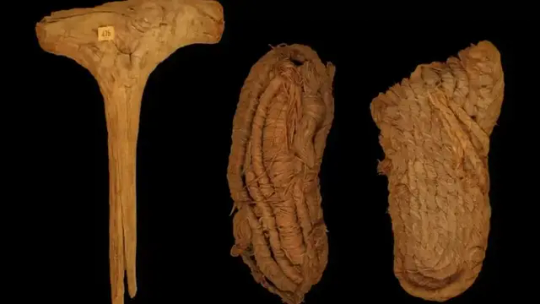
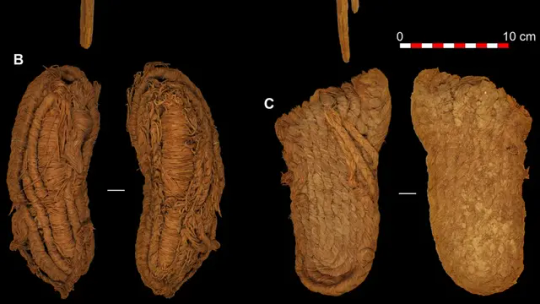
6,000-Year-Old Sandals Found in a Spanish Cave are Europe’s Oldest Shoes
New analysis has identified the oldest shoes ever discovered in Europe, according to a study published this week in the journal Science Advances.
The 22 woven sandals date from 6,000 years ago, radiocarbon analysis found in the study led by researchers at the Autonomous University of Barcelona and Alcalá University in Spain.
The ancient footwear, along with Mesolithic baskets and other tools, was first discovered back in 1857, when a cave in southern Spain was looted by miners. However, when the artifacts were first dated, in the 1970s, they were identified as being about 1,000 years more recent than this latest analysis found.
The very dry conditions within the cave were ideal for preserving perishable materials, the researchers said, and allowed the preservation of a prehistoric burial site complete with partially mummified corpses, accompanied by baskets, wooden tools, sandals and other goods.
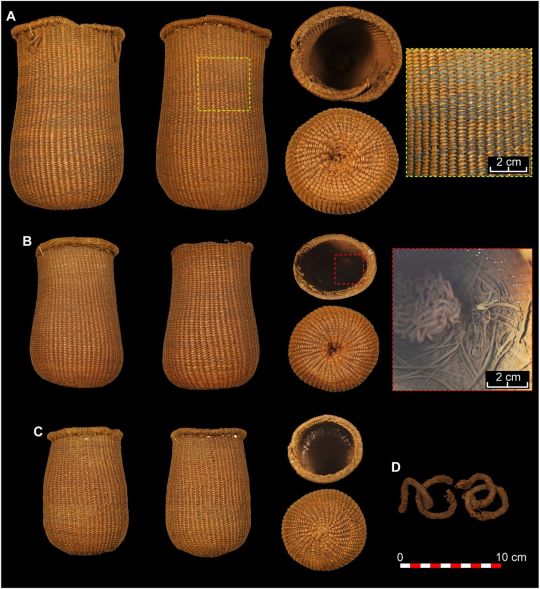

The objects are “the oldest and best-preserved set of plant fiber materials in southern Europe so far known,” María Herrero Otal, one of the study’s authors, said in a statement, adding that they demonstrate “the ability of prehistoric communities to master this type of craftsmanship.”
When Spanish archaeologist Manuel de Góngora y Martínez visited the cave in 1867, 10 years after the looting, he gathered the remaining artifacts, including the sandals, and gave them to museums in Madrid and Granada, where they have been studied by researchers, the study added.
The sandals were made of grasses as well as other materials, including leather, lime and ramie bast, a type of natural fiber.
Using the descriptions provided by Góngora, the study hypothesizes that the bodies were buried wearing the sandals.
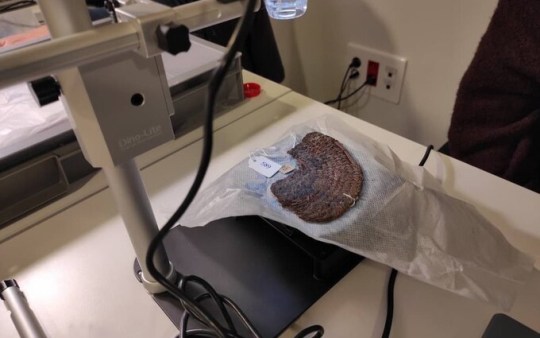
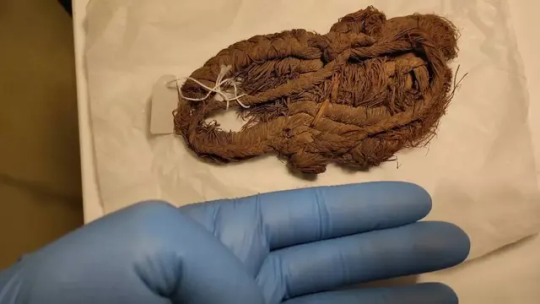
Some sandals had clear signs of wear, while others appeared never to have been worn, suggesting that some people had clothing made especially for their burial.
The researchers also studied several baskets and other wooden artifacts in the collection. These objects “open up groundbreaking perspectives on the complexity of Early-Middle Holocene populations in Europe,” they said, adding that most knowledge of past societies is drawn from durable artifacts rather than perishable ones such as baskets. The Holocene is the current geological epoch, which began 11,700 years ago.
Both the baskets and sandals suggest that the makers had an extended knowledge of the plant resources in the local environment as well as a high level of expertise, the researchers noted.
“The quality and technological complexity of the basketry makes us question the simplistic assumptions we have about human communities prior to the arrival of agriculture in southern Europe,” Francisco Martínez Sevilla, one of the study’s authors, said in a statement.
The study also found that the objects were deposited at the site at two very different times during the Early and Middle Holocene eras. The first phase was related to the Early Holocene hunter-gatherer populations, and the second phase to Middle Holocene farmers, researchers said.
By Issy Ronald.
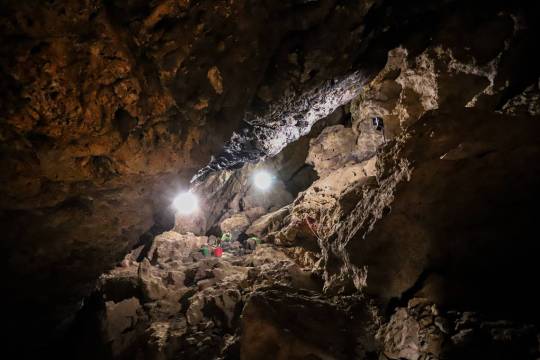
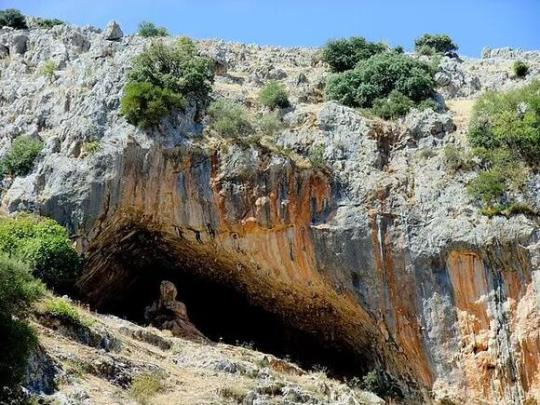
#6000-Year-Old Sandals Found in a Spanish Cave are Europe’s Oldest Shoes#the oldest shoes ever discovered in Europe#Cueva de los Murciélagos#the Cave of the Bats#Andalusia Spain#ancient artifacts#archeology#archeolgst#history#history news#ancient history#ancient culture#ancient civilizations
129 notes
·
View notes
Text
Something you might not know bout me is that I really like historical architecture.
I blame OSP Blue for that one video on neoclassical architecture because that video changed my brain chemistry forevermore.
I’m not an expert or anything but it brings me joy. Sometimes it’s the history and the designs and all that went into it.
And sometimes it’s just I am simple person who sees old building and bam serotonin.
Particularly renaissance and islamic architecture. And recently I got to visit the Alhambra palace in Granada, Spain.
Which combines both of those of styles.
And oh my lord I could’ve deadass just spent the whole day there. It was so breathtakingly beautiful. I dragged my family around because I wanted to see all the little details.
I was staring up at that ceiling and every little arch I came across. And I may have looked a wee bit insane but ah well I had a fun time.
Definitely gonna be looking more stuff up about it now I’m back home.
Because damn.
8 notes
·
View notes
Text
Chronicle Of A Concert
Chapter 1: The Concert Anouncement
First: Käärijä anounces he'll give a concert in Spain in September.
Me, in Mexico and with no plans to go: OMG! That's so cool! People from Spain and other countries nearby can go see him. Awesome! Good for them!
Then: I find out Tarja Turunen and Marko Heitala are also gonna be there, the day right before Käärijä.
Me, still not planning to go: Oh wow! That's gonna be great! I've read reviews that say they sound like Nightwish...more than Nightwish! I bet they're gonna play The Phantom of the Opera...
After that: I find out the venue is a medieval castle.
Me, having a meltdown: Holy sh*t, is castle! It's a castle! An actual castle! OMG, imagine listening to Phantom of the Opera in a castle...OMFG! Imagine listening to Paidaton Riehuja in a castle!
And finally: I find out the events are not in a festival, but in fact are separate individual concerts, which means more time for each artists.
Me: *Flights from Cancun to Spain*
Chapter 2: Talking To Everyone
At work:
Me: Hey, so...how do vacations work here? I know they're technically not paid, but how many days can I take?
Accountant: Depends on the date. When are you planning to take them?
Me: September.
Accountant: Oh, sure! Take a month for all I care!
To my parents:
Me: What would you say if...instead of going to my cousin's wedding, and spend my birthday at my cousin's wedding...I went to Spain for a couple concerts instead?
Dad: Go.
To my boss:
Me: I'd like to take some days off in September, is that ok?
Boss: Which part of September? Because I leave on the 15th.
Me: Oh, it would be during the first half.
Boss: Sure, how many days are you taking?
Me: I was thinking 2 weeks...
Boss: Why so much? Where are you going?
Me: I wanna go to Spain.
Boss: Oh, great! Sure! Make it worth it! But, I need you to be here on the 12 tops, so why don't you leave on late August, like the 28, 29 and come back between the 10-12? And you could work part time for a week so you don't go without a pay for all that time?
Me: You know what? That's actually a great idea.
Chapter 3: Planning
So...where the hell is Fuengirola and how do I get there? Ok, it's in the south, close to Marbella...damm, it's gonna be expensive.
The closest airports are Granada and Seville. The tickets to those are expensive. I'm gonna have to fly to Madrid.
How do I get from Madrid to Fuengirola? Oh, the closest city is Málaga...and it's only like 3 hrs from Madrid by train or bus...ok ok ok ok...so it's doable...
And how do I get from Málaga to Fuengirola?...oh, public transport, I see...great!
Hey, it's not actually as expensive as I thought at first.
Hmm...the direct flights from Cancun to Madrid are 9hrs long...pfff...I've done 11.
Chapter 4: The Story So Far...
I have the plane tickets, the concert tickers and I booked a hostal in Madrid downtown. I still need to book a place in Fuengirola tho...
I’m currently learning the Madrid Subway system and planning what to do for the time I'll be there (I’m going to a couple museums, there's a park I want to visit and a flea market that is a few blocks away from where I’m staying).
I already have my outfit for the concert (just need the shoes) and I’m thinking about making bracelets to give away.
23 notes
·
View notes
Text




Through the Years → Queen Letizia of Spain (2,494/∞) 1 April 2025 | Queen Letizia visits the Mind, Brain and Behavior Research Center (CIMCYC) of the University of Granada, in Granada (Andalusia, Spain). Queen Letizia has come to Granada on the occasion of the presentation of the Chair in Psycho-Neuro-Immunology-Clinical, a science that studies the interaction and communication between the different body systems. (Photo By Alex Camara/Europa Press via Getty Images)
4 notes
·
View notes
Text
@hetaberia-week
Day 1: historical .
.
1539,
Lisbon
A man in his crew had made a comment that had stayed with him hours after they had reached the capital. In fact, Portugal was still thinking about it when he finally left the Casa da Índia and crossed the short distance to the Ribeira Palace, walking up the stone steps in the winding staircases, nodding at the palace staff that passed him by and greeted him demurely, and, being himself clad in black, it had taken him a moment to realize everyone was too.
No bad news ever comes unaccompanied, his crewmate had said, and Portugal was still thinking of that when he opened the door to the King’s private drawing room, finding him with his eyes red-rimmed, clutching a letter to his chest in anguish. The Empress of the Holy Roman Empire, his younger sister, had died in May, he said, her last pregnancy had robbed her much of her strength, the child had not survived either. Portugal still smelled of gunpowder and ash, he could still feel grains of Indian sand inside his boots, but his eyes were lost on some unidentifiable corner of the King’s private drawing room as he sat down before his desk. They never lived long, did they. He had held her as a baby in his arms, had seen her learn her first words of his language, had attended her wedding, had visited her children. Their lives went by so fast, not like his.
There would be a funeral and the King wanted him to accompany him, Portugal did not think to say no. He was tired, battered, hurting, ears still ringing from cannon blasts shot across the Indian coast by Ottoman ships into his fortress in Diu, wearing months of a siege they had at great pains finally won. No bad news ever comes unaccompanied, and he found himself on a carriage a few days later bound to Granada, crossing the border with his shoulders heavy with padded fabric, his hair combed and clean, golden rings on his fingers.
The husband, the Holy Roman Emperor, was not there when they reached the church. Unable to bring himself to say the final good-bye to his beloved wife, he had instead sent his son in his place, his first-born and only surviving son and heir, and the boy stood, stone-faced and ashen, accompanying his mother’s coffin into the small, packed full church alone.
How small he seemed at that moment. And Portugal would never forget that image, of the boy entering the church behind his mother’s casket, his posture stiff with grief, dark clothes too heavy, golden fleece too garish. It would be the last time he ever saw him as a child. Once the ceremony was over and the body was buried, the son would leave the marble grounds of that church forever changed. No bad news ever came unaccompanied.
From across the entrance to the church while the crowd dispersed, surrounded by a group of nobles and high-ranking clergymen, Spain spotted him and excused himself to come to him, the pull on the bottom of his stomach becoming stronger the closer he came, recognizing him as an old soul like himself, despite him being so much younger.
“We did everything we could to save her,” Spain said, taking Portugal’s numb hand between both of his in a comforting gesture.
It should be the other way around, Portugal thought, looking at his young face and red-rimmed eyes. It was Spain who had just lost a Queen and an Empress, Portugal had lost her long ago, the moment they had sent her away to be married in a political alliance, but Spain had just lost a companion, an advisor, a friend. Portugal should be the one comforting him.
What an odd creature this boy was, he thought, observing the brown curls that framed his youthful face, feeling the calluses on his fingers from handling sword and quill, looking into his olive green eyes that so reminded him of someone else.
Portugal laid his other hand on top of theirs.
“I’m very sorry for your loss,” he said, earnestly, and Spain’s composure cracked, his chin trembling as he turned his eyes down to nod at the ground, sniffling.
And how odd, he thought, how so very odd, that his first instinct had been to pull him into his arms, even though he didn’t.
--
Notes: Portugal is coming home from the Battle of Diu (1538), only to discover the Holy Roman Empress, Isabella of Portugal, had died in May, 1539.
59 notes
·
View notes
Text

@sherrylephotography My Spain trip . 5/8/23 Alhambra
Although I really only walked through Granada to get to Alhambra, I would say that Alhambra is the third best city I went to in Spain. But really it is a part of Granada if I understand correctly. Best if coming by train to take a taxi to Alhambra because it is all up hill. But we walked back to the train station from Alhambra through Granada and found Granada to be very quaint and wonderful.
Alhambra is one of the most famous monuments of Islamic architecture and one of the best-preserved palaces of the historic Islamic world, in addition to containing notable examples of Spanish Renaissance architecture.
The Alhambra was abandoned starting in the 18th century. In 1812, some of the complex's towers were blown up by the French during the Peninsular War.
You can see many ruin's, but there are buildings that are well preserved, with so much detail and design, and writings. Beautiful mirror water features , and mirror ponds, aqueducts with running water. Wonderful gardens with trimmed hedges and so many wonderful roses and other flowers. Lots of view points and stairs to climb. Will worth the visit
Alhambra spans nearly 26 acres, you can easily spend the day here. Although it is crowded with tourist the gardens are peaceful and gorgeous, so here you can get a reprieve form the crowds. The gardens alone are well worth the visit.
Across from the entrance of Alhambra is Gardens Albertos. We ate a excellent meal here and the atmosphere was relaxing too. I would recommend the meal of the day, great deal The Contessa cake desert was to die for, picture below.

#original photography on tumblr#sherrylephotography#alhambra#spain#vacation spain#my photography#travel#gimp
113 notes
·
View notes
Note
Hi Lola!! 💖 I'm sorry you're feeling sick! Have some End of the year questions to hopefully help! #17 and 22!
hey desi! thank you for the ask, the love heart in particular made me feel better 💜
17. post a picture from the end of the year.
the only photos i've got of myself from the end of this year are pole ones and i don't want to subject everyone to me half naked without consent so here's a better one:

22. favourite place i visited this year.
i really loved mallorca, spain, so i think i'm gonna have to say that. an honourable mention to granada and seville though because those two places also slapped. also, cordoba has really cute cats so i would also highly recommend!
thank you for the ask!
end of year asks here
21 notes
·
View notes